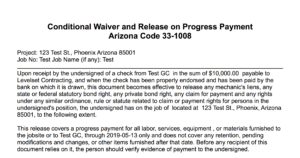
Arizona, as one of the 12 states that have specific lien waiver templates required by law, would seem to be removed from wording issues that cause problems and disputes regarding lien waivers in other states. However, any time payment issues raise their head and lien rights are at stake disputes follow, whether or not the form at issue is set out by statute. After all, tensions run high when payment is involved, and there are few things that lawyers won’t argue about.
One small section of the Arizona lien waiver template has a huge impact on a party’s lien rights – even for amounts not yet paid. And, failing to consider what this section causes the lien waiver to actually say can destroy lien rights even for amounts that the party delivering the waiver did not intend to waive.
“Through Date” might be the most important part of an Arizona waiver
“This release covers a progress payment for all labor, services, equipment or materials furnished to the job site or to __________(Person with whom undersigned contracted), through __________(Date) only and does not cover any retentions, pending modifications and changes or items furnished after that date.”
This seems relatively straight forward. An Arizona lien waiver related to a progress payment waives lien rights for a certain 
Attaching invoices or payment schedules to the waiver form does not get around this issue, either. If work has been done and not paid for the through date on an Arizona lien waiver must be before that work was performed, if the potential lien claimant wants to preserve lien rights. This result makes sense from an examination of the statutory lien waiver text itself and has been routinely supported by Arizona courts.
Examination of Arizona waiver text
As noted above, the text of Arizona progress lien waivers is set by statute. Accordingly, “filling in the blanks” is the only real control that can be exercised by the waiving party. An examination of the waiver text makes clear why it is crucial that the waiving party takes appropriate care to make the information on the waiver template internally consistent, as well as in line with what is actually understood and desired to be waived.
Progress waivers in Arizona start out with an amount to be paid to the waiving party. The receipt of that amount renders the wavier document effective “to release any mechanic’s lien, any state or federal statutory bond right, any private bond right, any claim for payment and any rights under any similar ordinance, rule or statute related to claim or payment . . . through [a certain] date.”
The words “any” lien, bond claim, or other payment right, related to “all” labor and/or material furnished, makes the wavier powerfully clear that the no lien may be claimed for work done prior to the through date after the waiver is provided, and that the amount noted on the waiver was sufficient for the work done through that particular date. If the waiving party desires to retain lien rights, the through date on the waiver must be adjusted to match up with the work for which payment has been or is being received.
While it seems clear that the through date sets a cut-off for lien protection when viewed in this manner, it is easy to see how confusion can exist. As well as including the through date, a lien waiver is also required to be dated when signed. It would not be difficult for somebody to (wrongfully) assume that the date of the waiver itself, or the date of the check, is the appropriate through date for use elsewhere on the form, and that including the unpaid invoices would make clear that there are amounts still due.
Arizona courts, though, are very clear in denying this approach.
Arizona courts and interpretation of through date
In Amfac Distribution Corp. v. J.B. Contractors, Inc., 703 P.2d 566, (Ariz. App., 1985) a seminal Arizona case involving the examination of how a lien waivers’ through dates relate to previous unpaid work, the Arizona court of appeals provides a clear view of why attaching unpaid (or not fully paid) invoices or payment schedules to lien waivers does not negate the wording of the waiver itself.
In the case, Amfac, the party providing the waiver, argued that it was only intending to relinquish lien rights related to the payments received, but not to waive lien rights for the materials supplied before [the through] dates but for which payment had not yet been received. Amfac supported this point with the fact that the waivers referenced “see attached invoices,” “see the attached check,” and “see attached sheets.” The court refused that argument, stating that the interpretation desired by Amfac was “unacceptable in light of the explicit terms of lien waiver forms tendered” and that a “mere showing of a balance was insufficient.”
Specifically, the court noted that “nothing in the words printed at the bottom of the waiver forms concerning attached ‘invoices, sheets, or check’ detracts from the wording of the lien release”, and that the solution to the problem was to be more careful in drafting the waiver to “show the proper date from which the lien waiver was to be effective.”
Arizona lien waiver through dates: takeaways and best practices
Given Arizona courts’ strong predilection for enforcing what waivers say with respect to the dates included, there are some pretty clear best practices to consider.
1. The date the lien waiver is signed and the through date are not necessarily the same
The date the lien waiver is created and signed is not necessarily the same as the “through date” that should appear in the document text. Considering billing practices, delays in payment or waiver exchange, and ongoing work on the project by the waiving party, it’s likely rarely the case that the date of the waiver and the “through date” of the waiver perfectly sync up. The “through date” is the date through which labor or material provided is no longer covered by mechanics lien protection, so if less than the full amount currently due is being obtained, the waiving party must determine the date that corresponds to the payment received.
2. The date of the check and the through date are not necessarily the same
Similarly to point 1, above, the date on which the check (or other payment) is made is rarely going to coincide with the “through date” of the waiver. The construction payment process is a process, and if payment was exchanged immediately every time costs were incurred, waivers would be of far less importance. But, since that’s not how the process works, the date of the payment is generally not the date through which a claimant would want to waive lien rights.
3. Have clear books and know when labor/material was furnished
Since the through date on a lien waiver is the factor that determines which labor or materials furnished to an Arizona project no longer enjoys mechanics lien protection, the waiving party must know when labor or materials were furnished, and the specific value of that labor or those materials.
If a lien waiver references an amount being paid that is less than the total amount currently outstanding, the party providing the lien waiver must be able to calculate the through date that corresponds with the amount being paid. And, the only way to do this is to make sure the “when” and the “how much” is clearly cataloged.
Arizona lien waivers make it clear that just because a state has statutory lien waiver templates, that doesn’t mean that filling out and providing a lien waiver is a mindless or simple task that doesn’t require attentive thought. Just like the unregulated states, it can be easy to waive more than intended.
Additional resources




